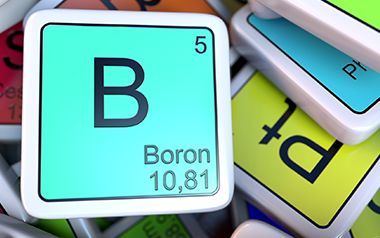Recommended Solutions:
There are four different solutions to treating boron removal depending on the water source and amount of contaminant present.
For brackish and well water sourced solutions, a reverse osmosis system is ideal to counter low amounts of boron (Scenario 1). Brackish/Well sourced water with high levels of boron should be treated with a reverse osmosis system and post-treatment to filter out the added remains (Scenario 2). To remove boron from seawater, a double pass reverse osmosis system is recommended to ensure the removal of boron (Scenario 3). Another treatment option for seawater is a seawater reverse osmosis system followed by a selective resin ion-exchange filter to specifically target boron removal (Scenario4).




[custom-specifications]
Boron is a naturally occurring element most often found as boric acid or boric acid salts. It’s chemical composition ranges from acid form (boric acid) to ion form. While it is most concentrated in water sources like seawater and well water due to other compounds that contain boron, it also occurs naturally in plants as a productive sugar mobilizer. Boron is a key component in the mitosis process of microorganismal growth making it present in plants and other products like fruits and vegetables. As boron is not a dietary requirement for humans, added sources of boron to the amount that is already consumed from foods is toxic for the human body. In addition, multiple salts and rocks are made up of compounds consisting of boron, which add up to the amounts of boron creating toxic effects on plants, animals, and humans alike. Toxicity affects the growth and product yield of plants and fish species suffer from high intakes of boron as well. Consuming only around 3 grams more than the required daily amount can result in nausea, vomiting, blood clotting, and any higher amounts can even be life threatening. Increased levels of boron in drinking water and soil have been correlated with individuals having arthritis. The World Health Organization (WHO) has consequently set a boron concentration limit for drinking water to be below 0.5 mg/L in addition to the standard of 1 mg/L for all other water applications.
The level of boron is associated to the level of salinity in seawater and total dissolved solids (TDS) in brackish/well water. Due to the lack of chemical charge that boron possesses, the means by which removal of boron is necessary can be quite complicated. Different water sources carry varying degrees of contaminants (compounded with boron) that are influenced by other varying factors like pH level and temperature which require different treatment processes in order to effectively purify water for the intended applications.
[/custom-specifications]
[custom-features]
Recommended Systems:
Some completed Boron Removal Projects:
[custom-usage]
Advantages of removing Boron:
-
- Safe drinking water
- Safe irrigation water: Eliminates concern of decreased product yield
- Removes overall TDS
- Environment-friendly
- Thorough elimination of contaminants
[/custom-usage]
[custom-documents]
[/custom-documents]
-
Quality content
Didn’t know how boron removal fromwater workedbefore. Thanks!
- Related Project1:
- https://pureaqua.com/industrial-desalination-plant-ion-exchange-132000-gpd-oman/
- Related Project2:
- https://pureaqua.com/industrial-seawater-reverse-osmosis-plant-32000-gpd-papua-new-guinea/
- Related Project3:
- https://pureaqua.com/industrial-water-maker-industrial-brackish-ro-unit-130000-gpd-in-oman/
- Related Project4:
- https://pureaqua.com/dual-bed-deionized-water-system-140-gpm-for-boiler-water-treatment-papua-new-guinea/
 ENGLISH
ENGLISH ESPAÑOL
ESPAÑOL العربية
العربية PORTUGUÉS
PORTUGUÉS FRANÇAIS
FRANÇAIS













